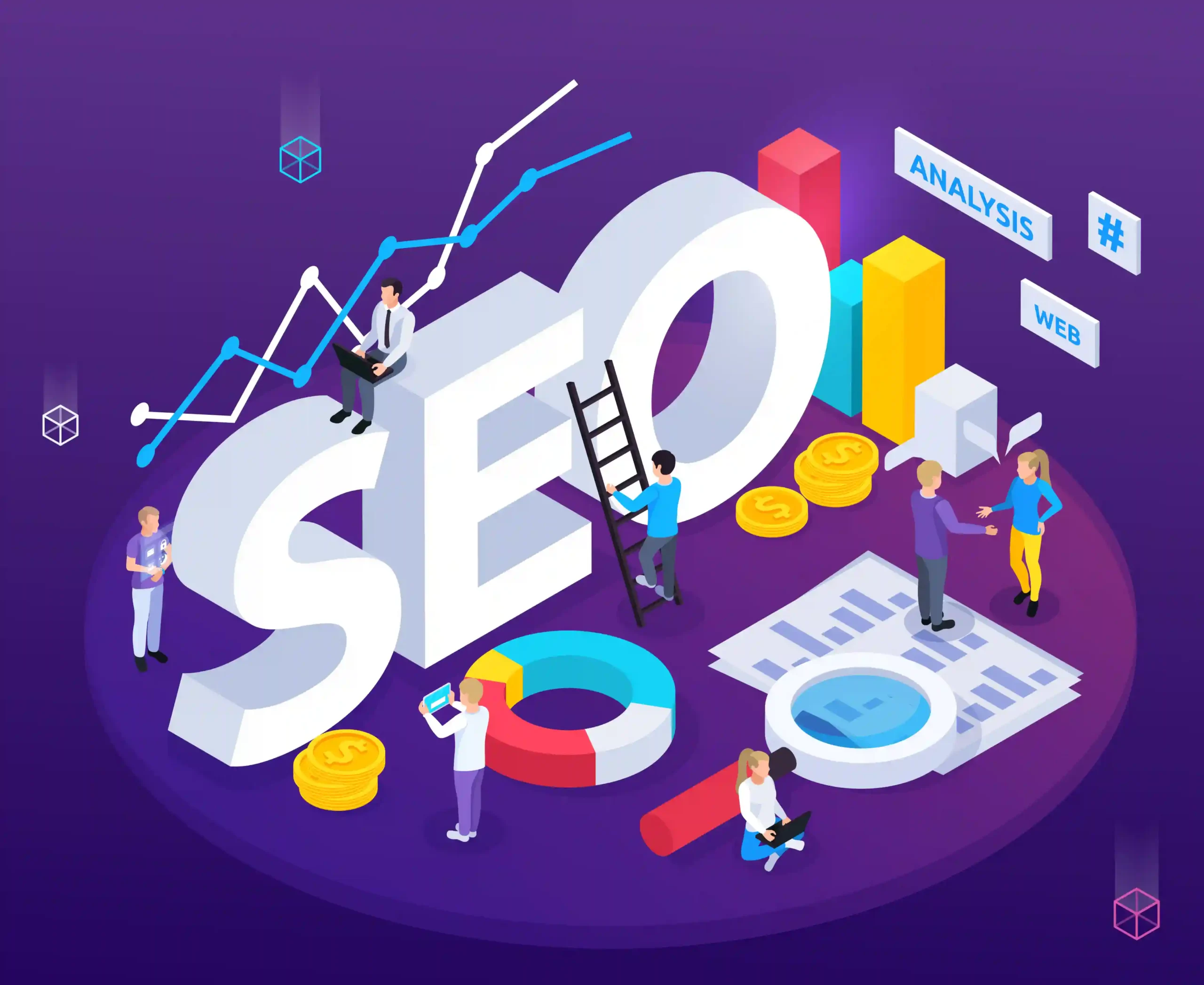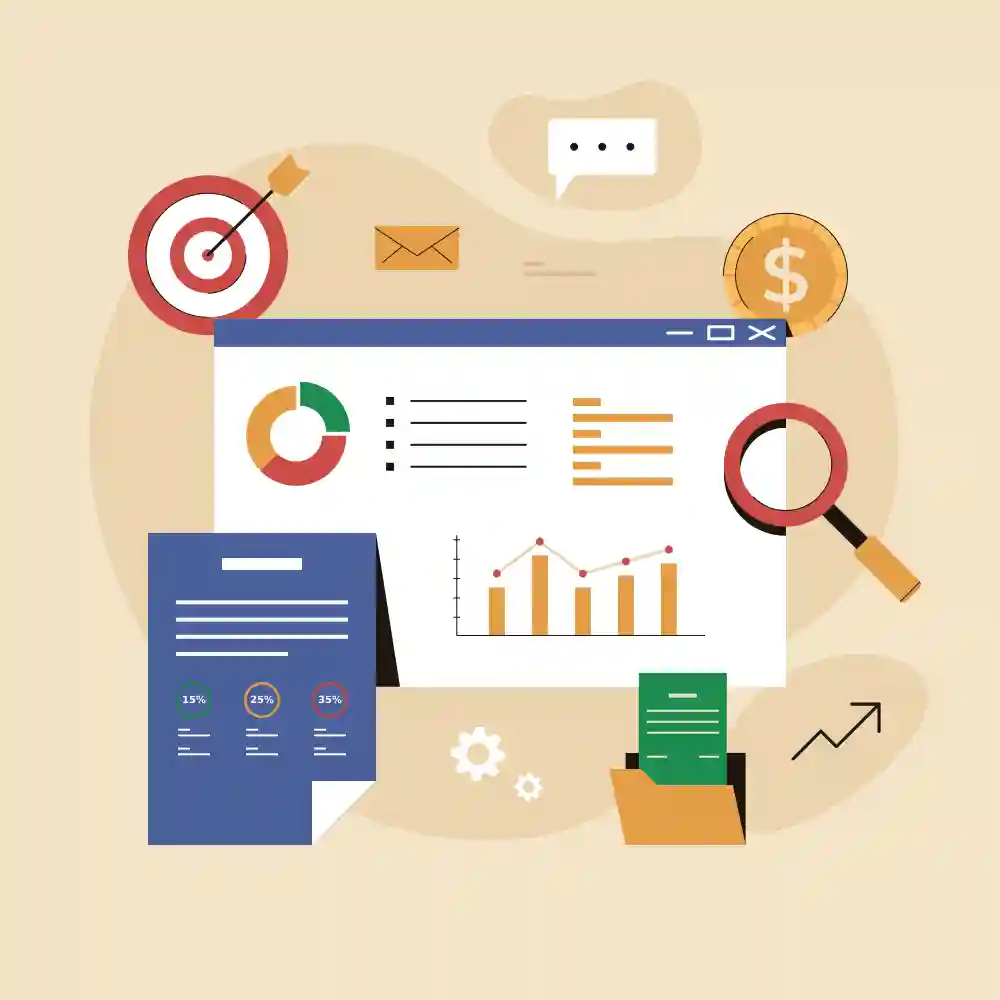Key Takeaways:
- SEO & AdWords Synergy complement each other for maximum online visibility and growth.
- SEO focuses on long-term success through organic traffic and credibility.
- AdWords provides instant visibility and precise targeting through paid ads.
- Benefits of Both: Increased visibility, keyword insights, double exposure.
- SEO offers organic traffic but requires patience. AdWords provides instant visibility but depends on budget.
- Offers comprehensive solutions leveraging SEO for long-term success and AdWords for immediate visibility.
In the vast digital landscape, where websites jostle for attention like eager performers on a crowded stage, two powerful players emerge: SEO and Google AdWords. These marketing strategies, when orchestrated harmoniously, can create a symphony of success for your business. Let’s dive into the intricacies of how they dance together, each step complementing the other.
What is SEO?

Search Engine Optimization (SEO) is the long-game champ. It’s like tending to a beautiful garden—cultivating your website and content to rank higher in organic search results. Imagine it as the diligent gardener who prunes, waters, and nurtures the plants, ensuring they thrive over time. SEO involves techniques such as:
Keyword Research
Keyword research is the cornerstone of any effective SEO strategy. It involves identifying the terms and phrases that your target audience is using when searching for products, services, or information related to your business. By understanding these keywords, you can optimize your website content to better match the search intent of your potential customers. The process of keyword research typically starts with brainstorming relevant topics and then using keyword research tools to identify specific keywords and phrases with high search volumes and low competition. These tools provide valuable insights into search trends, related keywords, and the competitiveness of specific terms.
Once you have compiled a list of potential keywords, it’s essential to prioritize them based on relevance, search volume, and competition. Long-tail keywords, which are longer and more specific phrases, can be particularly valuable as they often have lower competition and higher conversion rates. Keyword research is an ongoing process, as search trends and consumer behavior evolve over time. Regularly monitoring keyword performance and adjusting your strategy accordingly can help ensure that your website remains optimized for the most relevant and effective keywords in your industry.
Link Building
Link building is another crucial aspect of SEO that involves acquiring backlinks from other websites to your own. Backlinks serve as a vote of confidence from other sites and can significantly impact your website’s authority and ranking in search engine results.
There are various strategies for acquiring backlinks, including:
- Content Creation: Creating high-quality, valuable content that naturally attracts links from other websites.
- Outreach: Reaching out to other website owners and influencers to request backlinks or collaborations.
- Guest Blogging: Writing guest posts for other websites in exchange for a backlink to your own site.
- Directory Listings: Submitting your website to relevant online directories and listings.
It’s essential to focus on acquiring backlinks from authoritative and relevant websites within your industry. Quality is more important than quantity when it comes to link building, and spammy or low-quality backlinks can actually harm your website’s SEO performance.
On-Page Optimization
On-page optimization refers to the process of optimizing individual web pages to improve their search engine visibility and rankings. This includes optimizing various elements of the page, such as:
- Meta Tags: Optimizing meta titles and descriptions with relevant keywords to improve click-through rates from search engine results pages.
- Headers: Using headers (H1, H2, etc.) to organize content and signal the importance of specific sections to search engines.
- Content: Creating high-quality, relevant content that satisfies the search intent of users and incorporates targeted keywords naturally.
- URL Structure: Optimizing URLs to be descriptive and keyword-rich, making it easier for search engines to understand the content of the page.
By fine-tuning these on-page elements, you can improve your website’s relevance and authority in the eyes of search engines, ultimately leading to higher rankings and increased organic traffic.
How Does SEO Work?
SEO, or Search Engine Optimization, is a multifaceted digital marketing strategy designed to enhance a website’s visibility and relevance in search engine results pages (SERPs). While SEO does not provide immediate results like paid advertising, it is a long-term investment that can yield significant benefits over time. Let’s delve into how SEO works and why it is an invaluable asset for businesses looking to establish a strong online presence.
Understanding Search Engines
To comprehend how SEO operates, it’s essential to first understand how search engines function. Search engines like Google, Bing, and Yahoo use complex algorithms to analyze and rank billions of web pages based on their relevance and authority in response to user queries. These algorithms consider various factors such as keyword relevance, website quality, backlink profile, user experience, and more.
Optimizing for Relevance and Authority
SEO aims to optimize websites to align with the criteria that search engines consider when ranking pages. This involves several key components:
Keyword Optimization: Identifying and incorporating relevant keywords and phrases into website content, meta tags, headers, and URLs to match user search queries.
Content Quality: Creating high-quality, informative, and engaging content that satisfies user intent and provides value. Content should be well-written, unique, and tailored to target specific keywords and topics.
Technical Optimization: Ensuring that the website is technically sound and accessible to search engine crawlers. This includes optimizing site speed, mobile responsiveness, crawlability, and indexability.
Link Building: Acquiring high-quality backlinks from authoritative websites to demonstrate credibility and authority to search engines. This involves outreach, content promotion, and creating shareable content.
User Experience (UX): Enhancing the overall user experience of the website by improving navigation, usability, and accessibility. A positive user experience not only improves SEO but also encourages user engagement and conversions.
The Impact of SEO
While SEO requires patience and consistent effort, its benefits can be profound:
Increased Organic Traffic
By improving visibility in organic search results, SEO drives more targeted traffic to the website. Organic traffic tends to be more sustainable and cost-effective compared to paid advertising.
Cost Savings
As a website’s organic visibility and traffic grow, there may be less reliance on paid advertising channels like Google Ads. This can result in significant cost savings over time, as organic traffic is essentially free once established.
Long-Term Sustainability
Unlike paid advertising, which stops generating traffic once the budget runs out, SEO provides lasting benefits. A well-optimized website can maintain its search engine rankings and continue to attract organic traffic over the long term. Brand Credibility and Trust: Websites that rank prominently in organic search results are often perceived as more credible and trustworthy by users. Improved visibility in search engines can enhance brand reputation and authority within the industry.
What is Google AdWords (PPC)?

Google AdWords, now known as Google Ads, is a powerful online advertising platform that allows businesses to create and display ads on Google’s search engine results pages (SERPs) and across its vast network of partner websites. As a form of Pay-Per-Click (PPC) advertising, Google Ads offers instant exposure to businesses looking to increase their visibility and attract potential customers. Let’s explore how Google Ads works and its key features.
Creating Compelling Ads
The first step in using Google Ads is creating compelling ads that resonate with your target audience. This involves crafting attention-grabbing headlines, persuasive ad copy, and compelling calls-to-action. Google Ads offers various ad formats, including text ads, image ads, video ads, and responsive ads, allowing businesses to choose the format that best suits their goals and target audience.
Targeting and Bidding
Google Ads provides sophisticated targeting options to help businesses reach the right audience with their ads. Advertisers can target users based on factors such as keywords, location, demographics, interests, and device type. Additionally, Google Ads offers bidding options, allowing advertisers to set bids for their ads based on their budget and advertising goals. The bidding process determines when and where ads will appear in search results and how much advertisers will pay when users click on their ads.
Ad Auction and Ad Rank
When a user enters a search query relevant to your ads, Google Ads triggers an ad auction to determine which ads will appear on the SERP and in what order. The ad auction takes into account various factors, including bid amount, ad quality, and ad relevance. Google calculates an Ad Rank for each ad, which determines its position on the SERP. Advertisers with higher Ad Ranks are more likely to have their ads displayed prominently.
Cost-Per-Click (CPC) Pricing Model
Google Ads operates on a cost-per-click (CPC) pricing model, meaning advertisers only pay when users click on their ads. The cost of each click is determined by factors such as keyword competitiveness, ad quality, and ad relevance. Advertisers can set a maximum CPC bid, which represents the maximum amount they are willing to pay for a click. Google Ads automatically adjusts bids in real-time to help advertisers achieve their desired ad positions while maximizing their return on investment.
Instant Visibility
One of the primary advantages of Google Ads is its ability to provide instant visibility to businesses. Unlike organic search engine optimization (SEO), which can take time to produce results, Google Ads allows advertisers to place their ads directly on the SERP, ensuring immediate exposure to users actively searching for relevant products or services. This instant visibility can help businesses generate leads, drive website traffic, and increase sales in a short period.
Google Ads, also known as Google AdWords, is a powerful advertising platform that offers instant exposure to businesses looking to increase their online visibility and attract potential customers. By creating compelling ads, targeting the right audience, and bidding strategically, advertisers can maximize the effectiveness of their campaigns and achieve their advertising goals. With its cost-effective CPC pricing model and ability to deliver immediate results, Google Ads remains a valuable tool for businesses of all sizes looking to reach their target audience and drive business growth.
How Does AdWords Work?
Google AdWords, now known as Google Ads, operates as a powerful spotlight illuminating your business stage. It’s tailored for new ventures or those seeking instant attention in the digital arena. Even before your SEO strategies mature and bear fruit, AdWords swiftly positions your brand in the spotlight. It’s akin to securing a front-row seat at a concert – ensuring that people notice your presence even before you’ve attained rockstar status. With AdWords, businesses can swiftly gain visibility and capture the attention of their target audience, propelling them into the limelight of online success.
The Dynamic Duo: SEO and AdWords

Combining the powers of SEO and AdWords creates a dynamic duo that can propel your online presence to new heights. Think of your website as a captivating novel, with SEO laying the groundwork for a compelling narrative and AdWords serving as the attention-grabbing neon sign that beckons passersby. Let’s delve deeper into how these two forces work together to drive success.
SEO: The Patient Groundwork for Long-Term Success
SEO operates as the patient gardener tending to your digital garden, carefully nurturing your website to ensure long-term success. Much like setting the stage for an enthralling story, SEO lays the groundwork by optimizing your website’s structure, content, and visibility in search engine results pages (SERPs). Here’s how SEO sets the stage for success:
- Keyword Research and Optimization: SEO begins with meticulous keyword research to uncover the terms and phrases your target audience is searching for. By strategically incorporating these keywords into your website content, meta tags, and headers, SEO ensures that your website ranks prominently for relevant search queries.
- Content Development: High-quality, informative content lies at the heart of SEO success. SEO-driven content development involves creating engaging, valuable content that satisfies user intent and addresses their needs and queries. From blog posts and articles to product descriptions and landing pages, compelling content establishes your website as a valuable resource in your industry.
- Technical Optimization: Beyond content, SEO encompasses technical optimizations to enhance your website’s performance and accessibility. This includes optimizing site speed, improving mobile responsiveness, implementing schema markup, and ensuring proper indexing by search engine crawlers.
- Link Building: Building a robust backlink profile is another critical aspect of SEO. By acquiring high-quality backlinks from authoritative websites, SEO strengthens your website’s authority and credibility in the eyes of search engines, ultimately improving its ranking potential. While SEO may take time to yield results, its focus on sustainable, organic growth lays the foundation for long-term success. By investing in SEO, businesses can cultivate a strong online presence that continues to bear fruit over time.
AdWords: The Adrenaline Shot for Immediate Impact
In contrast to the patient approach of SEO, AdWords operates as the adrenaline shot that delivers immediate impact and visibility. It’s the neon sign that grabs attention and directs traffic to your website in real-time. Here’s how AdWords accelerates your online presence:
- Instant Visibility: With AdWords, businesses can bypass the waiting period associated with SEO and instantly place their ads at the top of search engine results pages (SERPs). This immediate visibility ensures that your brand is prominently featured when users search for relevant keywords, driving immediate traffic to your website.
- Targeted Advertising: AdWords offers precise targeting options, allowing businesses to reach their ideal audience based on demographics, interests, location, and search intent. By serving ads to users actively searching for products or services like yours, AdWords ensures that your message reaches the right people at the right time.
- Flexible Budgeting: AdWords provides flexibility in budgeting, allowing businesses to set their own budgets and bids based on their advertising goals and financial constraints. Whether you’re a small startup or a multinational corporation, AdWords accommodates businesses of all sizes and budgets.
- Performance Tracking and Optimization: AdWords offers robust analytics and reporting tools that allow businesses to track the performance of their ads in real-time. By monitoring key metrics such as click-through rate (CTR), conversion rate, and return on investment (ROI), businesses can optimize their campaigns for maximum effectiveness and efficiency.
By combining the patient groundwork of SEO with the immediate impact of AdWords, businesses can create a comprehensive digital marketing strategy that delivers both long-term sustainability and immediate results. Together, these two forces form a dynamic duo that can propel your online presence to new heights, ensuring that your website stands out in the crowded digital landscape.
Benefits of Using Both Together
Integrating both SEO and AdWords into your digital marketing strategy offers a multitude of benefits that can significantly enhance your online presence and drive business growth. From increased visibility to valuable keyword insights and double exposure in search results, the synergy between SEO and AdWords creates a powerful combination that amplifies your brand’s reach and impact. Let’s explore these benefits in more detail:
Visibility
By utilizing both SEO and AdWords, your website can achieve maximum visibility in search engine results pages (SERPs), effectively waving its digital flag for all to see. SEO ensures long-term visibility by improving organic rankings and increasing your website’s presence in unpaid search results. On the other hand, AdWords delivers immediate visibility by placing your ads at the top of SERPs for targeted keywords. Together, they ensure that your brand stands tall, akin to being at the center of Times Square during New Year’s Eve, where your presence commands attention amidst the digital crowd.
Keyword Insights
AdWords provides valuable insights into which keywords resonate most with your audience and drive the highest engagement and conversions. By analyzing the performance of your AdWords campaigns, you can gain valuable intelligence about the effectiveness of specific keywords, ad copy, and landing pages. This information can then be leveraged to fine-tune your SEO strategy, optimizing your website content and meta tags for the keywords that have proven to be most effective in driving traffic and conversions. In essence, AdWords acts as a testing ground for keyword experimentation, providing actionable data that can inform and enhance your SEO efforts.
Double Exposure
Imagine the impact of your brand appearing in both organic search results through SEO and paid search results through AdWords simultaneously. This double exposure not only increases the likelihood of attracting clicks and engagement but also reinforces your brand presence and credibility in the eyes of users. It’s akin to having a billboard and a newspaper ad running concurrently, ensuring that your brand message reaches potential customers through multiple touchpoints. With both SEO and AdWords working together, your brand gains greater visibility and prominence in the digital landscape, maximizing your chances of capturing the attention of your target audience.
The Unspoken Truth
When comparing AdWords and SEO, here’s what nobody talks about: They’re not rivals; they’re partners. Like Batman and Robin, they work best together. AdWords can test the waters, gauge audience response, and inform your SEO strategy. Meanwhile, SEO builds a solid foundation for lasting success.
Pros and Cons
SEO Pros
1. Organic Traffic: SEO drives organic traffic to your website, meaning visitors find your site through unpaid search results. This traffic tends to be more sustainable and cost-effective in the long run.
2. Cost-effectiveness: Once established, organic traffic generated through SEO requires minimal ongoing investment compared to paid advertising channels like AdWords.
3. Credibility: Websites that rank highly in organic search results are often perceived as more credible and trustworthy by users, enhancing your brand’s reputation and authority.
SEO Cons:
1. Patience Required: SEO is a long-term strategy that requires patience and consistent effort. It may take time to see significant results, especially for competitive keywords.
2. Unpredictable Algorithm Changes: Search engine algorithms are constantly evolving, making it challenging to predict and adapt to algorithm updates that may impact your website’s rankings.
AdWords Pros
1. Instant Visibility: AdWords provides immediate visibility for your website by placing ads at the top of search engine results pages (SERPs) for targeted keywords, ensuring instant exposure to potential customers.
2. Precise Targeting: AdWords offers precise targeting options based on demographics, interests, location, and search intent, allowing you to reach your ideal audience with tailored messaging.
AdWords Cons:
Budget-dependent: AdWords campaigns require a budget, and the effectiveness of your campaigns may be limited by your advertising budget. Once the budget is exhausted, your ads will no longer appear in search results.
Short-term Impact: Unlike SEO, which can deliver long-term results, the impact of AdWords campaigns is often short-term. Once you stop running ads, your visibility and traffic will decrease accordingly.
How SEO and SEM work together?

SEO (Search Engine Optimization) and SEM (Search Engine Marketing) are two essential components of digital marketing. While they serve distinct purposes, they can work together synergistically to enhance your online presence and drive results. Let’s explore how they complement each other:
- Keyword Synergy: SEO and SEM share a common foundation: keywords. SEM data can guide your SEO keyword research. Understanding which keywords drive conversions in paid ads helps optimize your organic content. By aligning your keyword strategies, you create consistency across both channels.
- Content Alignment: SEM campaigns often lead users to specific landing pages. Align these landing pages with relevant SEO content. When users encounter consistent messaging and relevant information, it enhances their overall experience. This alignment also reinforces your brand message.
- Data Insights: SEM provides valuable data on user behavior, keyword effectiveness, and conversion rates. These insights can inform your overall marketing strategy, including SEO. For example, if certain keywords perform exceptionally well in SEM, consider incorporating them into your organic content.
- Visibility Boost: While SEO is a long-term strategy, SEM offers immediate visibility. When you run paid ad campaigns, your website appears prominently in search results. This visibility complements your organic rankings, especially during competitive periods or product launches.
- Testing Ground: SEM serves as a testing ground for keywords, ad copy, and landing page performance. Use the learnings from SEM to refine your SEO approach. If a particular keyword converts well in SEM, optimize your website content around it.
SEO and SEM work together seamlessly. By leveraging their strengths, you can create a holistic digital marketing strategy that maximizes your reach, drives traffic, and ultimately leads to conversions.
How can Crongenix help?
As a digital marketing service provider, Crongenix understands the intricate dance between SEO and Google AdWords and the immense value they bring to businesses in the digital landscape. With our expertise in both SEO and AdWords, we offer comprehensive solutions designed to maximize your online visibility, drive targeted traffic to your website, and ultimately, boost your business growth. Through our meticulous SEO strategies, we work as the diligent gardener, cultivating your website to rank higher in organic search results. Our team conducts in-depth keyword research to uncover the terms and phrases your target audience is searching for, optimizing your website content to match their search intent. We also focus on building a strong backlink profile and enhancing on-page elements to improve your website’s relevance and authority in the eyes of search engines. With our SEO efforts, we lay the groundwork for long-term success, ensuring that your website continues to attract organic traffic and leads over time. In parallel, our expertise in Google AdWords allows us to provide instant visibility and targeted exposure for your business. We craft compelling ad campaigns tailored to your specific goals and target audience, ensuring that your ads appear prominently in search engine results pages (SERPs) for relevant keywords. By leveraging precise targeting options and strategic bidding strategies, we help you reach potential customers at the right time and place, driving immediate traffic and conversions to your website.
At Crongenix, we believe in the power of synergy between SEO and AdWords. By combining these two powerful marketing strategies, we create a harmonious approach that delivers both short-term impact and long-term sustainability for your business. Whether you’re looking to increase organic visibility, drive immediate traffic, or achieve a combination of both, our team is dedicated to helping you achieve your digital marketing goals and maximize your online success. Let us be your partner in navigating the dynamic world of digital marketing and unlocking the full potential of your online presence.
Frequently Asked Questions (FAQs)
- What is Crongenix?
Crongenix is a digital marketing service provider specializing in SEO and Google AdWords. We help businesses maximize their online visibility, drive targeted traffic to their websites, and achieve business growth through comprehensive digital marketing strategies.
- How does SEO benefit my business?
SEO (Search Engine Optimization) enhances your website’s visibility and relevance in search engine results pages (SERPs), driving organic traffic to your site. This sustainable and cost-effective strategy improves your brand’s credibility, increases organic traffic, and fosters long-term success.
- What is the difference between SEO and Google AdWords?
SEO focuses on optimizing your website to rank higher in organic search results, while Google AdWords, now known as Google Ads, is a paid advertising platform that displays ads at the top of SERPs for targeted keywords. SEO provides long-term sustainability, while AdWords offers immediate visibility.
- How long does it take to see results from SEO?
The time to see significant results from SEO varies depending on factors such as keyword competition, website age, and industry. Generally, it may take several months to start seeing noticeable improvements in organic rankings and traffic, but the long-term benefits are substantial.
- Can Crongenix help with both SEO and Google AdWords?
Yes, Crongenix offers comprehensive solutions for both SEO and Google AdWords. Our team of experts can develop tailored strategies to improve your organic visibility through SEO and drive immediate traffic through targeted AdWords campaigns.
